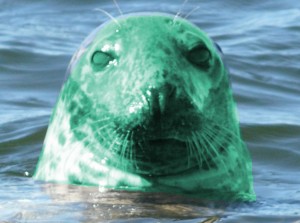 A report from Yale University’s Environment 360 Magazine out today says Japan is just not offering enough data and information for world scientists to feel confident that radioactive water dumped or leaked into the ocean near the Fukushima Daiichi power plant will not cause impact fish and marine mammals. Elizabeth Grossman writes that major, long-term studies will have to be conducted to figure out how radiation is moving through the ocean and food chain. The plant has released massive amounts of long-lived cesium, which travels up the food chain.
A report from Yale University’s Environment 360 Magazine out today says Japan is just not offering enough data and information for world scientists to feel confident that radioactive water dumped or leaked into the ocean near the Fukushima Daiichi power plant will not cause impact fish and marine mammals. Elizabeth Grossman writes that major, long-term studies will have to be conducted to figure out how radiation is moving through the ocean and food chain. The plant has released massive amounts of long-lived cesium, which travels up the food chain.
The Japanese government continues to reassure the world. They’ve closed off fishing nearby. The ocean dilutes the toxins. The common radioactive material, iodine, has a half-life of just 8 days. But not everyone is so confident. Japanese National Federation of Fisheries Cooperatives says the toxic water will kill off their business regardless of whether it kills the fish. They’ve shut off the big leak, but continue to dump less radioactive water. Airborne particles also end up in the water.
“My biggest concern is the lack of information. We still don’t know the whole range of radioactive compounds that have been released into the ocean, nor do we know their distribution,” Ken Buesseler, a senior scientist at the Woods Hole Oceanographic Institution on Cape Cod, told Grossman. “We have a few data points from the Japanese — all close to the coast — but to understand the full impact, including for fisheries, we need broader surveys and scientific study of the area.”
The Japanese news service, NHK, reported cesium-137 a million times the legal limit at least 20 miles from the plant. Xinhua says low levels of cesium-137 and -134 have turned up in 22 of 34 coastal provinces. The Christian Science Monitor reported that the Japanese plant has already released 80% of the amount cesium-137 released by Chernobyl–and that’s only 10% of the amount it has in the three reactors in worst shape.
Kyodo News advises the Japanese that the big worry is Cesium, which has a 30-year half life and “tends to accumulate in the muscle…It is also possible for it to become concentrated in bigger fish in the food chain.” One study shows the half life in fish may be only 50 days–but that may just mean they urinate it out–back into the water. Kyodo recommends discarding of fish skins and offal. Fish high up the food chain are pretty much the same ones you avoid for mercury poisoning: tuna, shark, swordfish, king mackerel and tilefish. (And for the Japanese, dolphins and whales.)
Grossman did a thorough job of tracking the marine life impacts of other radiation spills in the ocean. Here’s what she reports.
- A UK plant released cesium into the Irish Sea in the 1950s and contaminated fish, seals and porpoises. A 1999 study found those marine mammals still had 300 times the radiation as the water.
- Radioactive material from Sellafield and from the nuclear reprocessing plant at Cap de la Hague in France spread to the North Atlantic and Arctic Oceans.
- The Russians are not forthcoming on where and why they’ve released radiation, but in the 1990s, however, seals died of blood cancer in the Barents Sea and millions of starfish, shellfish, seals and porpoises died in the White Sea.
It’ll be a long time before we know the impact of the radioactive water release around Japan.

[…] Yale: data unclear that Fukushima is safe […]